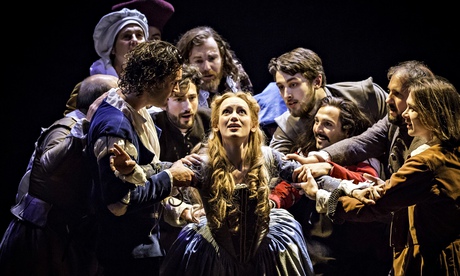You have no items in your cart. Want to get some nice things?
Go shopping
Director Declan Donnellan’s Shakespeare is surrounded by people. They push and bend to see him, they gasp when he picks up his quill, they lean in, eyes wide, unspeaking. His every move is observed by this crowd of eyes, and beyond the crowd are hundreds more watching from the seats of the Noel Coward Theatre in which this production of Shakespeare in Love is being performed. The scrutiny is fitting: it is one William Shakespeare has had to endure for centuries.
The production has been adapted by Lee Hall from the 1998 film of the same name. In our first glimpse of Shakespeare in Marc Norman and Tom Stoppard’s movie he is also writing, his fingers stained with ink, his room littered with cast-off sheets of paper. What great character is he creating now, we wonder. A new Falstaff, perhaps, a Hamlet to be read and reimagined over the years? The camera zooms and we see it is himself that he is committing to paper, his name written over and over again with different spellings: “Will Shagsbeard… W Shakspur… William Shaspur.” His own hand forecasts his chameleon-like future. His legacy, like his signature, he cannot determine.
The works of Shakespeare have been endlessly adapted. They have been relocated to the future, to the past, upon every continent and in every tongue; Litro‘s own recent Shakespeare issue demonstrated the Bard’s versatility. Terence Hawkes suggests that “Shakespeare is our invention: to read him is to write him” – and he is right. With each new set of eyes upon the “summer’s day” of Sonnet 18 it is reimagined, the emphasis shifted, the meaning changed. And repeatedly this sonnet’s creator is given the same treatment, drawn and redrawn in peoples’ minds from the scant biographical information we have inherited about him. A case in point: Lee Hall, adapting Norman and Stoppard’s screenplay for the stage, has our poor, protean Shakespeare unable to write. “Shall I compare thee to a… something something?”, he asks his blank page pathetically. It is Marlowe who supplies the line and furnishes the sonnet with its conceit.
In 1928 Virginia Woolf published Orlando, a novel about a man born in Elizabethan England, who endures through centuries, who changes sex, who sees the Thames freeze over and un-freeze itself, who travels and learns, who writes and entertains and loves. I mention Orlando only to compare him to William Shakespeare, who has suffered a comparable fate over the years, of ceaseless existence, of endless incarnation. Like Orlando, Shakespeare has witnessed the passing of centuries, and has developed according to the periods which shape him.
But what do these many incarnations say about us as readers? It is an interesting thought: that the world’s favourite character (and yes, I do mean “character”; he slips too often from history into fiction), can be read as something of a barometer for the mood of the age in which he was written.
For the Elizabethans, Shakespeare was, we presume, fact. He was flesh and blood, a husband, a father, a member of the Lord Chamberlain’s Men, a playwright. Then nothing, for some time, while his legacy is tested. He is found lacking in some quarters; Nahum Tate’s reimagining of King Lear with a happy ending proves more popular than the original for many years. And then, to skip a little, come the Romantics, and the birth of “Bardolatry”. In the pages of the nineteenth century poets this admiration becomes cloyingly sweet. The Shakespeare of De Quincey’s opinion “thought more finely and more extensively than all other poets combined”, while Keats in On Sitting Down to Read King Lear Once Again considers Shakespeare “Chief Poet”, and the act of reading his play akin to being “consumed in the fire”.
This adoration of Shakespeare by the Romantics feeds into the growing view of the playwright as representative, somehow, of the Establishment, a signifier of England (the notion of a politically conservative Shakespeare is notably put forward in Hartley Coleridge’s essay, Shakespeare, a Tory and a Gentleman). In 1930 he is employed to voice a jingoistic sentiment in G.A. Loessel’s A Midnight-Vision in Westminster Abbey. His statue argues: “Times, threatening the world with wreck and ruin,/ Prove Britons still, who ever, as of aye,/ Fight but to conquer…” What’s more, “to ensure that no nuances are lost,” Maurice O’Sullivan tells us in Shakespeare’s Other Lives, “the poem ends with directions for an orchestra to play ‘Rule Britannia’.”
He is given a talented sister by Woolf in A Room of One’s Own, a testament to the first seeds of feminism, and, a few decades later, Anthony Burgess introduces modern readers to a sexualized Shakespeare in his Joycean novel Nothing Like the Sun. The most recent additions to this survey restore us to the syrupy view of Shakespeare held by the Romantics. “Item, I gyve unto my wife my second best bed,” his will tells us, an ostensible unkindness which jars with our modern longing for happy endings. Carol Ann Duffy remedies this in Anne Hathaway, reinventing the second best bed as a place of love-making and poetry. And Norman and Stoppard contribute to this reconstruction of Shakespeare as a romantic hero, finding for him a beautiful muse to inspire the writing of Romeo and Juliet. Love, the movie poster tells us, is the only inspiration. Money is the only inspiration, a poster of Shakespeare’s own making might have read. Religion is the only inspiration, say the seventeenth century puritans. A thing of beauty is the only inspiration, insist the Romantics. But for us, apparently, it is love.
Not any sort of love, it must be noted. It is a heterosexual love, and one shared with an attractive, well-born woman. We can read here a conscious decision to homogenize Shakespeare’s love affairs. In researching interesting paths the screenplay might take, Marc Norman asked Shakespeare scholar Stephen Greenblatt for a corner of intrigue in the playwright’s life which might be developed upon for the film’s plot. Love, Greenblatt suggested. Let Shakespeare fall in love with Marlowe, and be caught up, somehow, in Marlowe’s murder in Deptford in 1593. The idea was rejected on commercial grounds: the general public did not want to see that sort of love story.
And while the current production of Shakespeare in Love is enjoyable, playing knowingly on the audience’s familiarity with the plays (“Out, damn’d Spot!”, Fennyman shouts at Spot the Labradoodle, wreaking havoc during a performance of The Two Gentlemen of Verona), there is a touch of smugness about it: it knows too well what its audience wants. Admittedly, much of what the production offers is what we want. Dialogue adapted from a brilliantly funny screenplay, a passionate pair of lovers (Tom Bateman and Lucy Briggs-Owen as Will and Viola), an assured Kit Marlowe (David Oakes), and a suitably condemning Elizabeth I (Anna Carteret), a fantastic set – which shifts to immerse us in the Curtain Theatre like groundlings of old – and, of course, a bit with a dog. Yet despite all of this glittering brilliance it seems mildly problematic to me that the Shakespeare that Hall, Norman and Stoppard have decided that we want to see is a hot-headed, heterosexual Lothario, of the ilk that graces modern-day movie posters everywhere. An obvious point, perhaps, but problematic nonetheless.
So, what next for Shakespeare? He will continue to be reincarnated for eternity: that much is clear. As Jorge Luis Borges wrote of him in his essay, Everything and Nothing: “No one has ever been so many men as this man who like the Egyptian Proteus could exhaust all the guises of reality.” Without doubt, he will be fictionalized forever – or “so long as men can breathe, or eyes can see”, as he himself foretold. Writers feel the need to complete him, to better him, to transform him into a smooth-talking protagonist, an honest and impassioned hero, the voice of England, even. I pity him this immortality. Hamlet speaks of death as a “sleep… [to] end the heartaches”, an “end warmly to be wished”. And yet it is an end that Hamlet’s constantly reincarnated creator will forever be denied.
Shakespeare in Love continues at the Noel Coward Theatre until October 25.

About Xenobe Purvis
Xenobe is a writer and a literary research assistant. Her work has appeared in the Telegraph, City AM, Asian Art Newspaper and So it Goes Magazine, and her first novel is represented by Peters Fraser & Dunlop. She and her sister curate an art and culture website with a Japanese focus: nomikomu.com.




